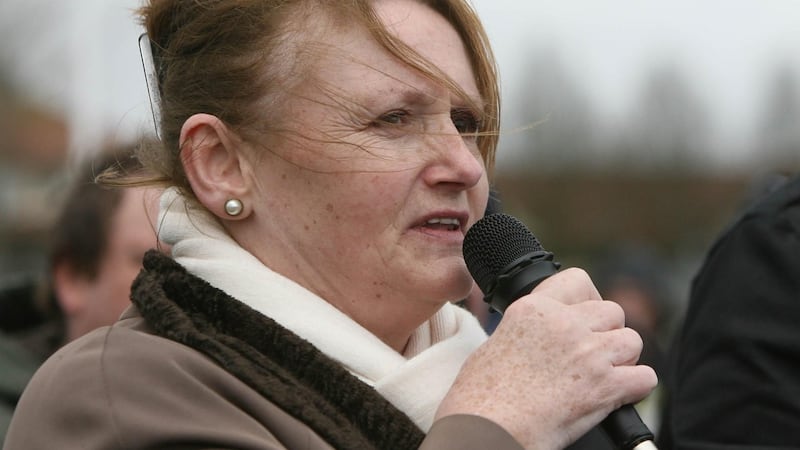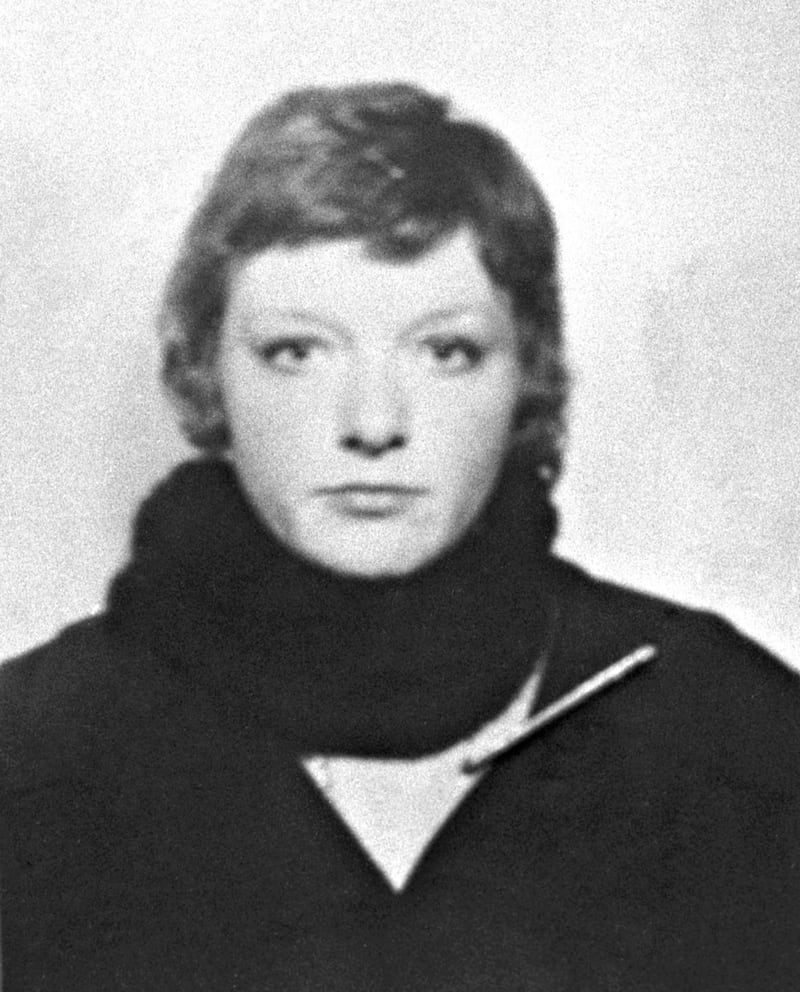The primary yet unproven allegation in Patrick Radden Keefe's book Say Nothing is that Marian Price was the third member of the three-person IRA squad that shot dead Jean McConville close to a beach in Co Louth in 1972.
But there is much more to the book, which addresses big issues such as murder, memory, trauma, grief, guilt, conscience and betrayal. There also are other key characters in the book, primarily the McConville family, and three people who once were intimates but became bitterly estranged: Dolours Price, Brendan Hughes (known as "The Dark") and Gerry Adams.
Marian Price’s late sister Dolours already had admitted that she and the late Pat McClure were part of the IRA unit that killed the 38-year-old widowed mother of 10 children – a deed that almost half a century on still carries a terrible resonance.

Despite his efforts, Keefe was unable to elicit a response from Marian Price to his allegation in Say Nothing that she was the third member of the unit. But her solicitor, Peter Corrigan, issued a statement to The Irish Times in which she “vehemently denies that she had any involvement in the murder of Jean McConville”; that she “played no hand or part in her murder”; and that the allegation was “completely untrue”. Price, who has never been charged in connection with Jean McConville’s death, and is understood to have never been questioned by police over the offence, said she would not be elaborating on that statement.
Keefe, however, is standing by his allegation. He does so on the basis of a source who told him that Dolours had confided that the killing of Jean McConville was “something the sisters had done together”.

He discovered too that the third person had been offered the position of personal driver for Gerry Adams but that that person turned down the job. Separately Keefe had access to a transcript of an interview Dolours Price gave to journalist Ed Moloney as part of Moloney's researches for I, Dolours, a film he made with Maurice Sweeney.
‘Boring job’
In that transcript, Dolours Price told Moloney that Adams wanted Marian to be his driver but that Marian “refused because it was such a boring job”. The pieces appeared to fit together, further convincing Keefe in his belief about what happened Jean McConville.
Some people thought Dolours and Marian Price were twins although Dolours, born in 1951, was older by three years. She was 21, Marian was 18 when Jean McConville was murdered.
“One aspect of the story that was dismaying for me,” Keefe reflects, “is the idea that there are these fundamental questions about human dignity that many people seem to perceive exclusively through the optic of it’s either us or them.”
He recalls how when Dolours Price died in 2013 Marian Price, who was then still in prison, wanted to be released for the wake and the funeral (she was allowed attend the wake). He read the court papers where her lawyers and a psychiatrist made the valid argument that “when you lose a family member you really need to properly grieve”.
“I understand that,” says Keefe, while adding that the same standard should have applied to the McConville children who were orphaned in 1972, for years not knowing what happened their mother.
Keefe is a 42-year-old award-winning New York-based staff writer for the New Yorker magazine from Dorchester in Massachusetts. He has written two previous books, The Snakehead: An Epic Tale of the Chinatown Underworld and the American Dream, and Chatter: Dispatches from the Secret World of Global Eavesdropping. He is married to Justyna, a lawyer, and they have two young boys.
He got the idea of writing a book on Jean McConville after reading an obituary of Dolours Price in The New York Times in 2013. To him it seemed to encapsulate the history of the Troubles, starting in its early period when McConville was abducted, murdered and disappeared, and leading on to the controversy over the Boston tapes – the ill-fated oral history of the Troubles – which was a big story in the US at that time.
After an article he wrote for the New Yorker appeared in March 2015, he decided it merited a book, and that was for a number of reasons – one of them the reaction to the magazine piece.
"In the States people were saying, 'Oh, I thought that was all done and dusted.' Some people thought Ireland had effectively been reunified. I was a little astonished at the degree to which this was a learning curve for some readers of the New Yorker who tend to be reasonably plugged in."
Main driver
But it was the power of the story itself that was the main driver.
“There was something extreme about the circumstances of what happened to her. You get this one gunshot and in the squeeze of a trigger you orphan 10 kids and then you cast them out into this life that ends up being very difficult for all of them. It was the magnitude of that tragedy that was part of the reason for this, which is not to suggest you could not tell thousands of versions of this story.”
I came away with deep admiration for the degree to which they have coped with a series of circumstances that most of us could not even imagine
The McConvilles, as Say Nothing illuminates, had a hard life, many of them ending up in care, and all to varying degrees suffering the distress that goes with such experiences. There was strength too: it was Helen McConville – with her husband, Seamus McKendry – who started the organisation Families of the Disappeared. It began the process that eventually led to the recovery of her mother's body and many more of the Disappeared as well.
Says Keefe: “I spent quite a bit of time talking to the McConvilles and going over interviews they did and reading legal and other materials to reconstruct their story. I came away with deep admiration for the degree to which they have coped with a series of circumstances that most of us could not even imagine, and have done so with great dignity.”

He does not take a position on the allegation that the reason she was murdered was because she was informing for the British army – a claim fiercely resented and rejected by the McConvilles, and also formally rejected by former Police Ombudsman Nuala O’Loan – although he reasonably queries what a vulnerable, stressed, 38-year-old widowed mother of a large brood of children could usefully do for the army.
He says, “For those of us who are not personally affected, ultimately, in evaluating the savagery of what happened to her, I don’t think it matters. If there were a scenario in which she had in fact been an informer in some capacity, that would not in any way diminish the awfulness of what was done to her.”
The other main characters in this book are the very senior IRA figure Brendan “The Dark” Hughes, Dolours Price and Gerry Adams whose presence seems to loom over much of the work.
That goes back to the allegation that he had overall command of the IRA unit called the Unknowns that killed Jean McConville. He has consistently denied all such responsibility, but both Brendan Hughes and Dolours Price are on record as saying the buck stopped with him. He in turn contended their animus towards him was motivated by opposition to the peace process and the 1998 Belfast Agreement.
Embittered
Hughes ultimately ended up an embittered figure who smoked and drank himself to death – he died in 2008 – while Price similarly died from the abuse of drink and prescription drugs in 2013. It seems the horrors of what they were involved in, and what they finally saw as the futility of the IRA campaign, got to them.
However, Adams prospered, politically and personally, and that too, as is evident from Say Nothing, stuck in the craw of Price and Hughes.
Keefe doesn’t have much truck with Adams’s denials.
“The trouble with denying things that everybody knows are true is that the value of anything that you say begins to steadily depreciate. He makes specific denials of things I say in the book but he also makes general denials that he was ever in the IRA, and everybody knows that he was. As a journalist and an outsider I have a strong bias for the truth and I don’t believe you should obfuscate the past. In some ways that is the thesis of this book. I don’t take Adams’s denials very seriously.”
But there is tribute too in the book to Adams where it is due. “Adams is an endlessly fascinating character. He will find a lot in the book to object to but there will be many people who read the book and feel I am far too sympathetic to him.”

Towards the end of Say Nothing Keefe refers to what he calls Adams’s “sociopathic instinct for self-preservation”, and writes, “It is hard not to sympathise with Hughes emotionally. But politically, it would be folly not to sympathise with Adams . . . Whatever callous motivations Adams might have possessed, and whatever deceptive machinations he might have employed, he steered the IRA out of a bloody and intractable conflict and into a brittle but enduring peace.”
In this interview he says Adams “became famous for caveated expressions of regret”.
“I think he is a survivor and has been one since childhood,” says Keefe. “That is a key aspect of his nature. He did not allow himself to be consumed by all that happened. This is a man with a tremendous capacity for detachment and compartmentalisation and an ability to shut himself off emotionally from what is happening all around him. That is part of what was so maddening to some of the people who fought alongside him in their youth. They ended up tortured by what they all went through and he seems kind of impervious to it.”
Analysing
Dolours Price, too, needed a lot of analysing.
“I think she did have a conscience and I think it was very difficult for her,” says Keefe. “But I also think that she had a pride and enduring feeling that she should not have to apologise for what she did in war. . . I tended to feel she had a very hard, cold side but she had a much warmer and ultimately very mournful side as well.”
Belfast is a profoundly screwed-up place, and yet there's such a warmth to the people and this particular kind of gallows humour that laughs in the face of it all
Keefe said that Hughes had the same conflict.
“But in the end Hughes was in a place where there were no caveats, he just felt regret.”
Say Nothing is a potent work. There is character and plot and pace to the narration. Keefe, over his seven visits to Northern Ireland for the book, developed a real feel for the place and the people.
“Belfast is a profoundly screwed-up place,” Keefe adds, “and yet there’s such a warmth to the people and there is this particular kind of gallows humour that laughs in the face of it all. I wanted to capture that as best I could. On the one hand this is a very plangent story. On the other hand it is a story of human resilience. In the face of it all there was love and there was fun and crazy moments of absurdity, and there was humour throughout. My purpose was to braid some of the awfulness with some of those lighter moments.”
With his fresh eye Keefe catches why the murder of Jean McConville is a universal and timeless story, and why, after all those troubled years since she was buried in a lonely grave in Co Louth, it still plays on the psyche of the Irish people.
He concludes: “I realise there is a certain audacity in coming here to this place which has suffered so greatly and where people are deeply aware of the history. I do that, I hope, with an appropriate sense of humility. But I also think there is a value to being an outsider. I came in knowing very little and I would tell the story as I saw it.”









